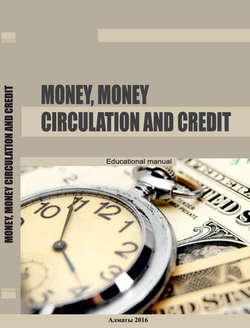Money, money circulation and credit

Реклама. ООО «ЛитРес», ИНН: 7719571260.
Оглавление
Коллектив авторов. Money, money circulation and credit
INTRODUCTION
Chapter I. MONEY
Section 1. THE ESSENCE AND FUNCTIONS OF MONEY
1.1.1. The necessity and essence of money
1.1.2. The functions of money
Section 2. MONEY TURNOVER, MONEY CIRCULATION AND MONEY SYSTEM
1.2.1. Metal full-bodied money
1.2.2. Paper money and their circulation consistency
1.2.3. Credit money
1.2.4. Electronic money
Section 3. MONEY CIRCULATION
1.3.1. The meaning of money circulation
1.3.2. Cash-in-hand flow and its organization
1.3.3. Cashless money turnover and its forms
1.3.4. The payment service of Kazakhstan
Section 4. MONETARY SYSTEM
1.4.1. The meaning of monetary system and its elements
1.4.2. The law of money circulation
1.4.3. Monetary stock and monetary base
1.4.4. The essence and mechanism of banking multiplier
1.4.5. Inflation: essence, reasons, types, consequences
1.4.6. The peculiarities of inflation processes in Kazakhstan
1.4.7. The monetary reform of Kazakhstan of 1993: its necessity and procedure of conduction
Section 6. LOAN CAPITAL, INTEREST AND CREDIT
1.6.1. The economic essence of credit
1.6.2. Functions of credit
1.6.3. The essence and kinds of interest
1.6.4. The origin of loan resources forming
1.6.5. Forms of credit
Section 7. CREDIT AND BANK SYSTEMS. TYPES OF LOAN INSTITUTIONS
1.7.1. The meaning of credit system and its structure
1.7.2. Types of bank institutions
1.7.3. Specialized loan-financial institutions
Chapter II. THE CENTRAL BANKS – THE KEY LINKS OF CREDIT BANK SYSTEM
Section 8. THE CENTRAL STATE BANK, ITS ESTABLISHMENT AND DEVELOPMENT
2.8.1. Appearing of new central issuing banks
2.8.2. The primary objectives and functions of the developed countries central banks
2.8.3. The structure and juridical status of the National Bank of Kazakhstan
Section 9. FUNCTIONS AND OPERATIONS OF THE NATIONAL BANK OF KAZAKHSTAN
2.9.1. The primary goal, tasks and functions of the National Bank of Kazakhstan
2.9.2. Operations and deals of the National Bank
Chapter III. COMMERCIAL BANKS, THEIR FUNCTIONS AND ACTIVITY ORGANIZATION
Section 10. THE PRINCIPLES OF COMMERCIAL BANKS ACTIVITY ORGANIZATION
3.10.1. The legal organizational form of banks
3.10.2. The basic functions and principles of banks’ activity organization
3.10.3. reorganization and activity termination
3.10.4. The meaning of banking license
Section 11. PASSIVE AND ACTIVE BANK OPERATIONS
3.11.1. Passive operations
3.11.2. Active operations
REFERENCES
ЛИТЕРАТУРА
Отрывок из книги
Money is probably one of the greatest inventions of a human thought. It hasn’t any analogues in an animated nature. The whole structure of the modern economy is determined by the existence of money. The world economy has two basic theories of the money origin: rational and evolutional.
According to the rational theory money is the result of an agreement between people who invented them as a special instrument used for goods exchange.
.....
After money invention people could find them usage only because they made one more great invention: all the goods could be compared to each other on the basis of their relative value and the value itself could be expressed by means of unified measurer – money. For the commodity-money operations different monetary units are used – tenge, dollars, marks, etc. These units measure and compare value of commodities. This function of accounting money is called standard of prices.
Money as a standard of value is homogeneous what is very important for counting and record keeping of implemented transactions. Expressing prices in dollars and cents people can compare and equalize the value of different goods immediately and freely.
.....